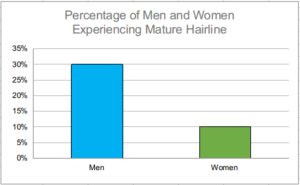How To Spot Differences: Mature Hairline Vs Receding Hairline
Introduction
Are you starting to notice changes in your hairline? It’s common for both men and women to experience changes in their hair as they age. Two types of hairlines we discussed are “mature hairline” and “receding hairline.” While they may sound similar, they have different causes and appearances. We will also look into hair loss stages and ways to hair care regardless of which stage you’re in. So let’s dive in and get to the root of the matter!
What is a mature hairline?
A mature hairline refers to the natural change that occurs in a person’s hairline as they grow older. This is a normal part of the aging process and usually begins during one’s late teens or early twenties. The hairline moves higher on the forehead, creating a more pronounced “M” shape. The hair may also become finer and less dense overall. It’s important to note that a mature hairline is not a sign of hair loss or baldness. It is a natural progression of your hairline as you age.
It is influenced by both genetic and hormonal factors, as well as individual variations in hair growth patterns. During adolescence, the body experiences hormonal changes that can affect the hairline. These changes in hormones can make your hairline move back a little, making you look a bit more grown-up.
The term “juvenile hairline” refers to the hairline seen in younger individuals. It usually sits lower on the forehead before growing into a mature hairline. It’s worth noting that a mature hairline is different from male pattern baldness or female pattern hair loss.
What Causes a Mature Hairline?
Here are some reasons why a mature hairline might show up:
1. Genetics: If your parents or grandparents had a mature hairline, you might get one too. It often runs in families.
2. Hormones: When you hit puberty, your body changes, including hormones. These hormones can make your hair thinner and shorter. It makes your hairline appear more mature.
3. Stress: Stress isn’t great for your hair. If you’re stressed out a lot, it might affect how your hair grows and changes your hairline.
4. Nutrients: A lack of essential nutrients can affect the health of the hair follicles. Eating healthy foods is super important for your hair too.
5. Health Conditions: Certain health issues like alopecia areata can make you lose hair. Sometimes, if you have alopecia areata, your hairline might look more mature because of it.
What does a mature hairline look like?
A mature hairline is a slight recession of the hairline on the sides, giving it a more grown-up look. The hairline may appear higher on the forehead, but there is usually no significant thinning or loss of hair in this area.
Here are some important things to notice:
Shape:
A. M-shape: This is the most common, with a receding hairline at the temples and a peak in the center. Imagine an upside-down “U” with gentle points on the sides.
B. V-shape: A subtler version of the M-shape. It resembles a widow’s peak with a slight recession at the temples.
C. Rounded: While less common, some mature hairlines retain a rounded or oval shape with minimal recession.
Density:
A. Fullness maintained: Unlike balding, the hair density at the hairline remains consistent. You may also observe no thinning or noticeable bald patches.
B. Gradual recession: The hairline may recede slightly. It’s a gradual and even process, not a rapid or patchy thinning.
What is a receding hairline?
A receding hairline, on the other hand, is a common symptom of male pattern baldness. This change often starts near the temples or forehead, making the hairline look like it’s moving up. In this case, the hairline begins to recede further back on the scalp, forming a “V” or “U” shape. Unlike a mature hairline where the hair remains intact, a receding hairline is accompanied by thinning or loss of hair in the affected areas.
Facts and studies concerning the receding hairline:
1. The American Hair Loss Association reports that around 50% of men and women experience hair loss by the age of 50.[1]
2. A 2017 study published in the Journal of the AAD found that male pattern hair loss (MPB) is around 52% in men aged 45-55. [2,3]
3. Research suggests that genetic factors contribute to approximately 80% of MPB cases. [4]
What causes receding hairline?
Genetics is also the main culprit behind a receding hairline. If your family has baldness in men, you’re more likely to have a receding hairline someday. Other factors can also contribute to hair loss and a receding hairline. Such as hormonal imbalances, certain medical conditions, and lifestyle choices.
A. Genetic: Our genes hold the blueprint for our hair. The androgen receptor gene dictates how sensitive our follicles are to dihydrotestosterone (DHT). Think of it as a tiny barber with a penchant for thinning strands and sculpting M-shapes.
Intriguing Stats:
I. 80% of male pattern hair loss is linked to genetics, passed down from one generation to the next.
II. 50% of women experience some degree of hair loss by 50, with genetics playing a role too.
B.Hormone: Estrogen and testosterone can disrupt the hair growth cycle. It may cause the development of receding hairline. Imagine them as mischievous pranksters messing with your follicular rhythm.
C. Stress: The stress hormone cortisol can be your hair’s worst enemy. It may disrupt the growth cycle and lead to receding hairline.
D. Medical Condition: Certain medical conditions can contribute to a receding hairline. Such as thyroid disorders, autoimmune diseases, and nutritional deficiencies.
What does a receding hairline look like?
Spotting the Early Signs of a Receding Hairline:
Recognizing the early signs of a receding hairline is crucial. Usually, your hair gets thinner on the sides and front of your head, making your forehead look bigger. Over time, the receded hairline may extend further back, leading to a larger balding area. Look out for a gradual thinning of hair along the temples and forehead area. Also the formation of a distinct “M” Shape.
Here’s what to watch for:
A. Temple Tango: A gradual thinning of hair along the temples. It often forms a subtle “widow’s peak” or a more pronounced “M” shape.
B. Hairline: Notice if your hairline is thinning, with fewer strands than before.
C. Parting Ways: Does your parting seem to be widening, or is it venturing further back than usual? This could be a sign of your hairline subtly changing its course.
Mature hairline vs receding hairline: what’s the difference?
Let’s summarize the specifics surrounding mature and receding hairlines.
| Feature | Mature Hairline | Receding Hairline |
| Description | Reflects a natural change with age. | Signifies hair loss typically around the temples or crown. |
| Causes | Age-related changes predominantly cause mature hairlines. | Genetic predispositions and hormonal factors often contribute to receding hairlines |
| Symptoms | Gradual hairline stability with slight temporal recession. | Noticeable frontal hair loss or thinning, often in a V-shape pattern |
| Prevention | Healthy lifestyle and using suitable hair care products. | Healthy lifestyle and avoiding excessive stress |
| Treatment | Addressing mature hairlines often involves embracing natural hair patterns | Treatments focused on hair regrowth and preservation. |
| Age of Onset | Usually starts in late 20s or early 30s. | Can start as early as teens, but more noticeable in late teens and early 20s. |
| Sex | Primarily affects men, but can also occur in women. | Primarily affects men, but can also occur in women, though less commonly. |
| Hairline Shape | Recedes slightly in a “V” shape or straight across. | Recedes further back, often in an “M” shape or hairline becomes significantly higher. |
| Rate of Recession | Slow and gradual. | Rapid and noticeable. |
| Hair loss | Minimal hair loss, primarily concentrated at the hairline. | Significant hair loss, thinning throughout scalp. |
| Prevalence | About 30% of men encounter a mature hairline by age 50, while around 10% of women do by age 30. | Roughly 25% of men experience a receding hairline, while women, by age 40, encounter hair thinning or loss within the range of 10-20% due to a receding hairline. |
The bar graph shows how many men and women have a mature hairline by the time they reach 50 years old.
About 25% of men develop a receding hairline, while around 10-20% of women face hair thinning by the time they are 40 years old.
Is a mature hairline a sign of male pattern baldness?
No, a mature hairline isn’t a sign of male pattern baldness. Male pattern baldness, a hereditary condition, leads to hair loss in certain patterns. Though a receding hairline may lead to androgenetic alopecia. A mature hairline is a normal part of aging and doesn’t involve major hair loss.
How to know if your hairline is receding or maturing?
If you’re unsure if your hairline is moving back or just changing naturally, watch for a few signs. A mature one moves back a bit, about 1 to 2 centimeters. While a receding one can move back a lot, even covering the whole top of the head. The receding hairline is often shaped like the letter “M,” especially around the sides. To tell the difference, experts use the classification of the Norwood Scale. This scale has 7 stages and helps doctors to determine stages of hair loss in individuals.
Conclusion
Remember, a mature hairline is normal as you get older. While a receding hairline might need special treatments. If you want to learn more about your hair and the genes causing hair loss, you may explore the HairLife DNA test. Take control of your hair health and make informed decisions.
Frequently Asked Questions
Can women experience a receding hairline?
Yes, women can also experience a receding hairline, although it is less common than in men. Female pattern hair loss tends to present as overall thinning rather than a distinct receding hairline.
Are there any natural remedies for preventing hair loss?
While there is no guaranteed natural remedy for preventing hair loss. However, a balanced diet, regular exercise, and managing stress can help keep hair healthy.
Is hairline genetic from the mother or father?
Hairline genetics can come from either parent. It’s not solely passed down from the mother or father but a combination of both parents’ genes.
What ethnicity has a receding hairline?
Receding hairlines aren’t specific to any ethnicity. People of various backgrounds can experience them.
Will I have a receding hairline if my dad has one?
Having a family history of a receding hairline might increase the likelihood, but it’s not a guarantee. Genetics play a role, but other factors also contribute, so it’s not certain that you will have one if your dad does.
Can hair transplant surgery reverse a receding hairline?
Yes, hair transplant surgery can restore a receding hairline.
What to do if your hairline is maturing?
Use gentle shampoo and conditioner, and avoid heat and harsh chemicals. Opt for a balanced diet, exercise, and specialized hair care products.
What to do if your hairline is receding?
To manage a receding hairline, try these: A) Use gentle shampoos, B) Massage your scalp, C) Reduce stress, and D) Eat a balanced diet.
Maturing hairline vs balding: What is the difference?
A mature hairline is a natural change as you age. Whereas balding involves noticeable hair loss and receding hairlines.
References
1. https://www.americanhairloss.org/
2. https://www.aad.org/public/diseases/hair-loss/treatment/male-pattern-hair-loss-treatment
3. https://pubmed.ncbi.nlm.nih.gov/9865198/
5. https://www.ncbi.nlm.nih.gov/books/NBK278957/
6. https://www.health.harvard.edu/decision_guide/hair-loss-in-women
7. https://www.americanhairloss.org/
Book a consultation
Simply fill in your details in the form below and we’ll get in touch with you shortly.







